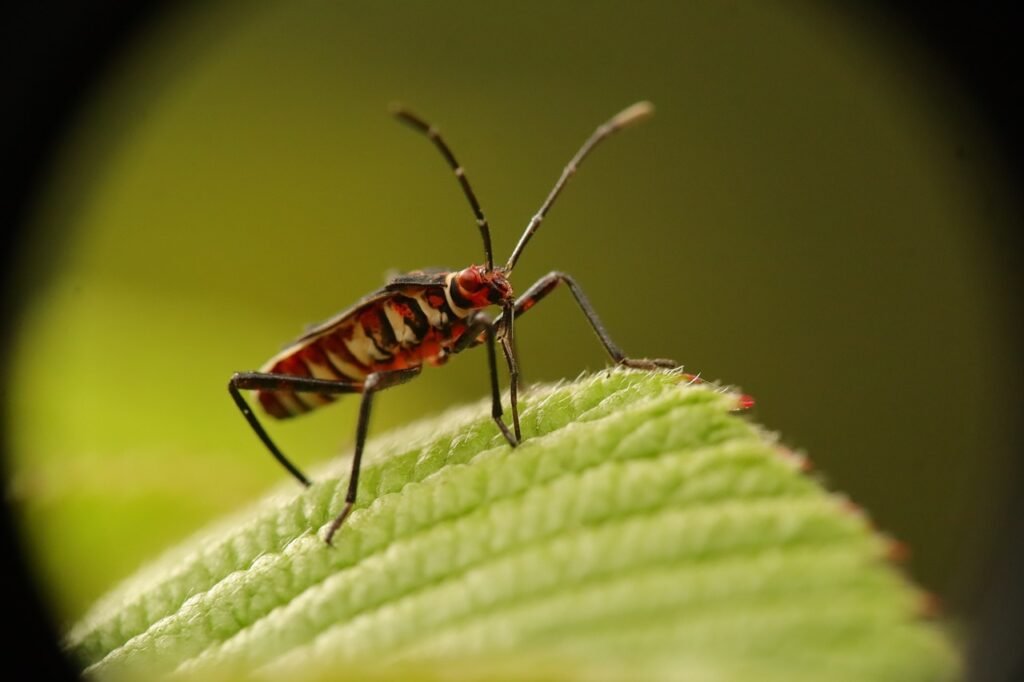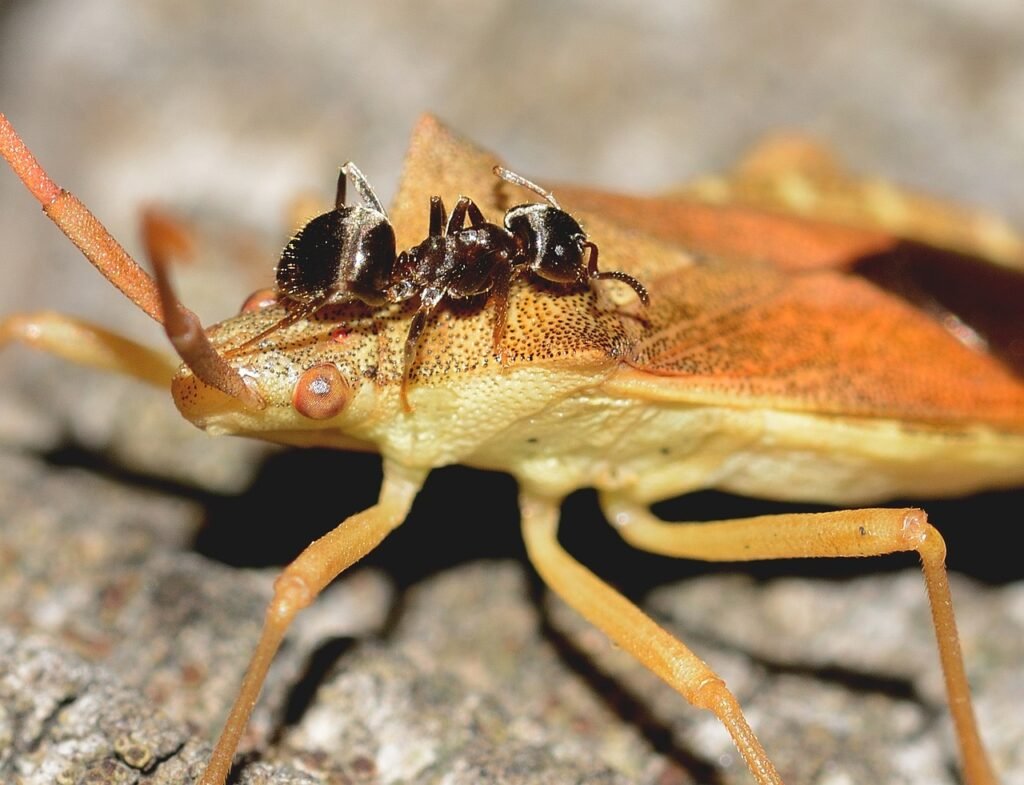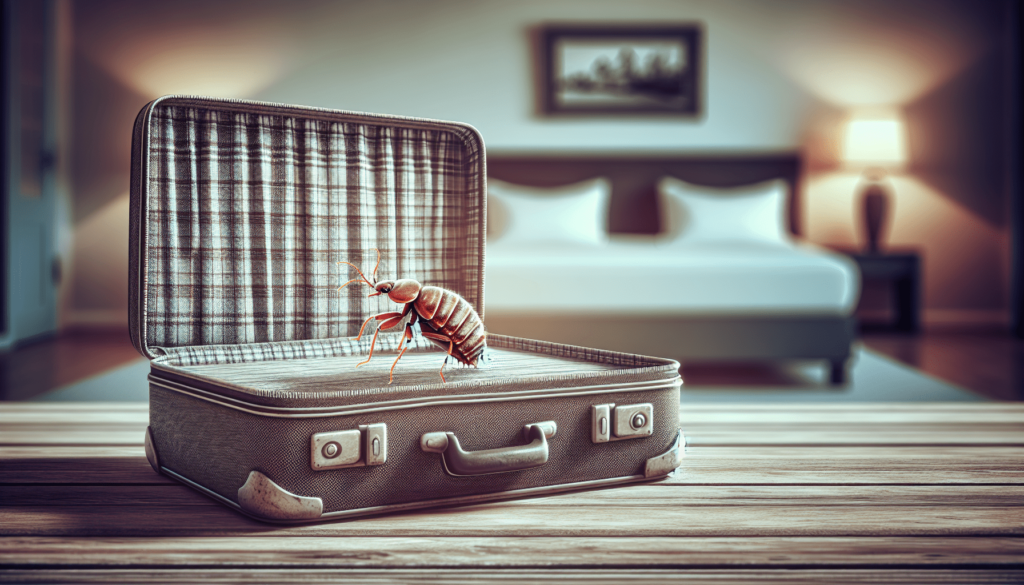Bed bugs can be an unwelcome visitor in any home, causing discomfort and frustration for those affected. But how do these pesky pests actually make their way into your house in the first place? Understanding how bed bugs enter your house is essential in preventing infestations and taking proactive measures to keep them at bay. In this article, we will explore the various ways bed bugs can infiltrate your living space, provide valuable insights from industry experts, and offer practical tips to safeguard your home. From travel to second-hand furniture, we will delve into the common pathways bed bugs take to enter your house, empowering you with the knowledge to protect your living space.

This image is property of pixabay.com.
Understanding Bed Bugs
Bed bugs are small insects that belong to the Cimicidae family. They are nocturnal parasites that feed on the blood of humans and animals. While they are commonly associated with infestations in beds and mattresses, they can also be found in other areas of the house. Understanding bed bugs is crucial in order to effectively prevent and manage their presence in your home.
Defining Bed Bugs
Bed bugs are tiny, oval-shaped insects that are typically brown or reddish-brown in color. They have flat bodies, which allow them to hide in tight spaces. Adult bed bugs grow to about 4-5 mm in length, while nymphs (young bed bugs) are smaller and translucent. They are often mistaken for other pests such as ticks or carpet beetles.
The Life Cycle of Bed Bugs
Bed bugs go through a life cycle consisting of several stages: egg, nymph, and adult. Female bed bugs can lay hundreds of eggs in their lifetime, which are usually laid in hidden cracks and crevices. The eggs hatch into nymphs, which molt several times before reaching adulthood. The entire life cycle from egg to adult usually takes about 5-8 weeks, depending on factors such as temperature and availability of food.
Bed Bugs’ Characteristics
Bed bugs are well-adapted to survive in human environments. They are attracted to the carbon dioxide and warmth that humans emit, making beds and sleeping areas their preferred habitats. However, they can also infest other furniture, cracks in walls, and even electrical outlets. Bed bugs are capable of surviving for several months without feeding, which allows them to go undetected for extended periods of time.
Categories of Bed Bugs
There are two main species of bed bugs that commonly infest human dwellings: Cimex lectularius and Cimex hemipterus. While Cimex lectularius is the more prevalent species in North America, Cimex hemipterus is found in tropical regions. Despite their differences in habitat, both species are equally capable of causing infestations and the same prevention and treatment methods apply.
Damage Caused by Bed Bugs
Bed bugs are not known to transmit diseases to humans. However, their bites can cause itchy welts and skin rashes in sensitive individuals. The psychological impact of bed bug infestations can also be significant, as the fear of being bitten and the resulting loss of sleep can lead to anxiety and stress. Furthermore, the presence of bed bugs can negatively affect the reputation of a household or business.
General Ways Bed Bugs Enter Houses
Understanding the common ways bed bugs enter houses is essential to prevent infestations. While bed bugs are excellent hitchhikers and can be found in various public spaces, they most commonly make their way into homes through a few main avenues.
Through Used Products
One common way bed bugs enter houses is through the introduction of infested used products. This includes used furniture, mattresses, and other household items. Bed bugs can hide in the seams and crevices of these items, and when brought into a new environment, they can quickly spread and establish an infestation.
From Infested Areas
Bed bugs can also enter houses from infested areas such as hotels, motels, and other places where people come and go frequently. They can hitch a ride on luggage, clothing, or personal belongings and find their way into new homes. It is important to be cautious when visiting such places and to thoroughly inspect and clean any items that may have come into contact with bed bugs.
Through Visitors
Another way bed bugs enter houses is through visitors. If someone who has a bed bug infestation in their own home visits your house, they may unknowingly bring bed bugs along with them. Similarly, if you visit a place that is infested with bed bugs and then return home without taking proper precautions, you may introduce bed bugs to your own living space.
Via Pets
Although less common, bed bugs can also be brought into houses through pets. Bed bugs can hitch a ride on the fur or bedding of pets and find their way into homes. It is important to regularly groom and inspect pets for any signs of bed bugs, especially if they have been in contact with infested areas or animals.
Detailed Ways Bed Bugs Enter Houses
Understanding the detailed ways bed bugs enter houses is crucial in order to implement effective preventive measures. By being aware of their potential entry points, you can take proactive steps to protect your home from infestations.
Through Clothing and Suitcases
Bed bugs are often encountered during travel, as hotels and public transportation are common infestation hotspots. They can easily hitch a ride on your clothing, especially in areas where they have established a significant presence. Additionally, they may find their way into your suitcase, allowing them to enter your home upon your return. It is important to thoroughly inspect your clothing and luggage after traveling and to wash or heat-treat them as a precautionary measure.
Through Used Furniture
Used furniture, particularly items with fabric upholstery, can harbor bed bugs. When purchasing second-hand furniture, it is crucial to carefully inspect every nook and cranny for any signs of bed bugs, such as live bugs, fecal stains, or shed skins. If possible, it is best to avoid purchasing used furniture altogether, as it is difficult to guarantee that it is bed bug-free.
Through Nearby Infested Areas
If your neighbors or nearby residences have a bed bug infestation, there is a risk that the bed bugs may migrate to your home. Bed bugs can easily move between adjacent units, especially in multifamily housing or apartments with shared walls. Regularly inspecting and monitoring your home for any signs of bed bugs can help you detect an infestation early and take prompt action to prevent its spread.
Through Visitors’ Belongings
When friends, family, or other visitors come to your home, they may unknowingly bring bed bugs with them. This can occur if they have recently stayed in a place with a bed bug infestation or if they have infested belongings. To minimize the risk of bed bug introduction, you can provide temporary isolation for visitors’ luggage and belongings, such as placing them in a designated area away from living spaces. Additionally, educating your guests about bed bug prevention measures can help prevent unintentional infestation.
Preventing Bed Bugs Entry
Preventing bed bug entry is essential to protect your home from infestations. By implementing proactive measures, you can significantly reduce the risk of bed bugs entering your living space.
Regularly Cleaning Your House
Regularly cleaning your house is an important step in preventing bed bug infestations. Vacuuming thoroughly, especially in areas where bed bugs may hide, such as mattresses, upholstered furniture, and cracks in walls, can help remove any potential hitchhikers. Additionally, washing bedding, linens, and curtains in hot water and drying them on high heat can kill any bed bugs or eggs that may be present.
Checking Used Products Before Bringing Them into Your House
When acquiring used products, such as furniture or clothing, it is crucial to thoroughly inspect them for any signs of bed bugs. Look for live bugs, fecal stains, shed skins, or eggs. Pay close attention to seams, crevices, and other hiding spots where bed bugs may be found. If you suspect an item may be infested, it is best to avoid bringing it into your home.
Avoiding Purchasing Used Furniture
While it may be tempting to purchase used furniture for cost-saving purposes, it is important to consider the risk of bed bug infestations. As mentioned before, used furniture can harbor bed bugs, and it is difficult to guarantee that it is bed bug-free. If purchasing new furniture is not an option, consider thoroughly inspecting and treating used furniture before bringing it into your home.
Temporary Isolation of Visitors’ Luggage
To minimize the risk of bed bugs being introduced into your home by visitors, you can provide temporary isolation for their luggage and belongings. Designate an area away from living spaces, such as a garage or mudroom, where visitors can store their belongings during their stay. This can help prevent any potential bed bugs from spreading to other areas of your home.

This image is property of pixabay.com.
Detecting Bed Bug Entry
Detecting bed bug entry is crucial in order to take prompt action and prevent a small infestation from becoming a larger problem. By being able to identify the signs of bed bugs, you can effectively tackle the issue early on.
Identifying Bed Bug Residues
Bed bugs leave behind various signs of their presence, known as bed bug residues. These can include dark stains or smears on bedding or furniture, which are caused by their excrement. Additionally, you may find shed skins and eggshells, indicating the presence of bed bug nymphs. Identifying these residues can help confirm the presence of bed bugs and prompt you to take immediate action.
Spotting Live Bed Bugs
Spotting live bed bugs is another clear indication of their presence. Adult bed bugs are visible to the naked eye and can be found hiding in cracks and crevices or in the folds of bedding. They are typically reddish-brown or brown in color and have a flat, oval-shaped body. Nymphs may be more difficult to spot due to their smaller size and translucent appearance.
Recognizing Bed Bug Bites
Bed bug bites can vary in appearance from person to person. They are typically red, itchy welts that may be arranged in a linear pattern or clustered together. However, bed bug bites can also be mistaken for other insect bites or skin conditions. If you suspect you have been bitten by bed bugs, it is important to seek medical advice for proper diagnosis and treatment.
Finding Bed Bug Nests
Bed bugs typically hide in nests during the daytime and come out at night to feed. These nests can be found in various locations, such as in mattress seams, cracks in walls, furniture joints, or behind baseboards. Thoroughly inspecting these areas can help you locate bed bug nests and determine the extent of the infestation.
Dealing with Bed Bug Infestation
If you have a bed bug infestation in your home, it is crucial to take immediate action to prevent it from spreading and becoming more severe. The specific approach to dealing with a bed bug infestation depends on the level of infestation and personal circumstances.
Managing a Light Bed Bug Infestation
If you have a light bed bug infestation with only a few isolated areas affected, you may be able to manage it on your own. Start by thoroughly cleaning and decluttering the affected areas, vacuuming all surfaces, and washing bedding and linens in hot water. It is also advisable to use bed bug-specific insecticides or natural remedies to treat the infested areas. However, it is important to follow the instructions on the products and take necessary safety precautions.
Handling a Severe Bed Bug Infestation
If you have a severe bed bug infestation or if the infestation persists despite your efforts, it is recommended to seek professional help. Professional pest control services have the expertise and tools to effectively eliminate bed bugs and prevent their return. They may use a combination of treatments, such as insecticide applications, heat treatments, or fumigation, depending on the severity of the infestation.
Engaging Professional Pest Control Services
When choosing a professional pest control service, it is important to select a reputable and experienced provider. Look for companies that specialize in bed bug control and have a track record of successful treatments. Additionally, consider obtaining multiple quotes and comparing the services offered before making a decision. Professional pest control services can provide a comprehensive treatment plan tailored to your specific situation, ensuring effective eradication of bed bugs.

This image is property of pixabay.com.
Health Implications of Bed Bugs
While bed bugs are not known to transmit diseases, their presence can have significant health implications for individuals living in infested homes. These implications can be both physical and psychological, affecting overall well-being and quality of life.
Physical Health Implications
Bed bug bites can cause a range of physical health issues. Some individuals may develop an allergic reaction to the bites, resulting in severe itching, swelling, and discomfort. The itchiness can lead to excessive scratching, which can potentially lead to secondary infections. In rare cases, bed bug bites may also trigger anaphylaxis in highly sensitive individuals. The physical symptoms of bed bug bites can cause sleep disturbances, leading to fatigue and decreased immune function.
Mental Health Implications
The presence of bed bugs can have a significant impact on mental health. The fear and anxiety associated with the possibility of being bitten can lead to sleep deprivation, paranoia, and heightened stress levels. Bed bug infestations are often stigmatized, leading to feelings of shame and embarrassment for the affected individuals. This can result in social isolation, decreased self-esteem, and a negative impact on mental well-being.
Sleep Quality Implications
Bed bugs are primarily active at night, feeding on human blood while their hosts are asleep. This results in interrupted sleep for individuals living in infested homes. The constant discomfort and fear of being bitten can make it difficult to fall asleep and stay asleep. Lack of quality sleep can lead to daytime drowsiness, irritability, and difficulties with concentration and focus. A prolonged period of sleep deprivation can have long-term implications on overall health and well-being.
Myths about Bed Bugs Entry
There are several myths and misconceptions surrounding the entry of bed bugs into homes. It is important to debunk these myths in order to have a clear understanding of how bed bugs enter houses and how to effectively prevent infestations.
Myth about Bed Bugs and Cleanliness
Contrary to popular belief, bed bugs are not attracted to dirty or unsanitary conditions. They are opportunistic pests that are primarily attracted to the warmth and carbon dioxide emitted by humans. Bed bugs can be found in both clean and dirty environments, as long as there is a source of blood for them to feed on. Maintaining a clean and clutter-free living environment can help with early detection and prevention, but it does not guarantee protection against bed bugs.
Misconception about Bed Bugs and Poverty
Another common misconception is that bed bugs are only found in low-income or poverty-stricken areas. Bed bugs can infest any living space, regardless of socioeconomic status. They are equal opportunity pests that can be introduced into homes through various means, as discussed earlier. Being aware of the potential entry points and implementing preventive measures can help protect any household from bed bug infestations.
Misunderstanding about Bed Bugs and Pets
While it is true that bed bugs can hitch a ride on pets and their bedding, they do not live on or infest pets like fleas. Bed bugs prefer human hosts and are more likely to establish their presence near sleeping areas. However, it is still possible for bed bugs to bite pets, causing discomfort and potential allergic reactions. Regularly inspecting and treating pets for bed bugs, especially if they have been in contact with infested areas, can help prevent the spread of bed bugs within a household.

Frequently Asked Questions about Bed Bugs
To further address common inquiries and provide comprehensive information about bed bugs, here are some frequently asked questions and their answers:
Can Bed Bugs Fly?
No, bed bugs cannot fly. They do not have wings and are unable to fly or jump like fleas. Bed bugs rely on their ability to crawl and move quickly to seek out hosts for blood meals.
Are Bed Bugs a Sign of Dirtiness?
No, bed bugs are not a sign of dirtiness. As previously mentioned, bed bugs are attracted to warmth and carbon dioxide, not dirt or unsanitary conditions. They can infest any living space, regardless of cleanliness.
Can Bed Bugs Transmit Diseases?
There is no evidence to suggest that bed bugs can transmit diseases to humans. While their bites can cause physical discomfort, bed bugs are not known vectors for diseases like mosquitoes or ticks.
How Fast Do Bed Bugs Reproduce?
Under optimal conditions, female bed bugs can lay up to 5 eggs per day, totaling over 200 eggs in their lifetime. The eggs hatch into nymphs, which reach adulthood within 5-8 weeks, depending on factors such as temperature and availability of food.
Can Bed Bugs Survive in Very Cold or Hot Conditions?
While bed bugs are capable of surviving in a wide range of temperatures, extreme cold or heat can be lethal to them. Exposing infested items to freezing temperatures or using high heat treatments can effectively kill bed bugs and their eggs.
Conclusion: Securing Your Home Against Bed Bugs
Understanding how bed bugs enter houses and implementing preventive measures is essential for maintaining a bed bug-free living environment. By regularly cleaning your house, checking used products before bringing them in, avoiding used furniture, and temporarily isolating visitors’ belongings, you can significantly reduce the risk of bed bug infestations. Detecting bed bug entry through identifying residues, spotting live bugs, recognizing bites, and finding nests is crucial for early intervention. In cases of infestation, managing light infestations and seeking professional pest control services for severe infestations are recommended. It is important to address the health implications of bed bugs, both physical and mental, and debunk common myths surrounding their entry. By providing comprehensive information and addressing frequently asked questions, individuals can better understand bed bugs and take proactive measures to secure their homes against these pests.

